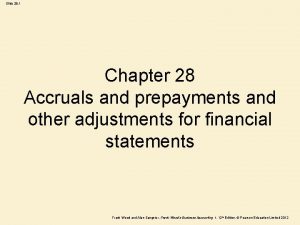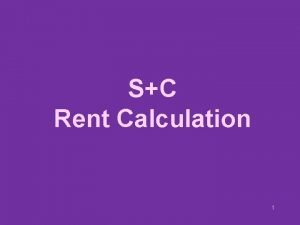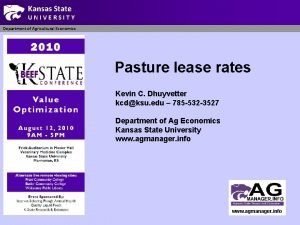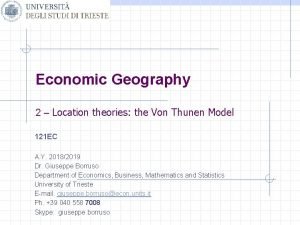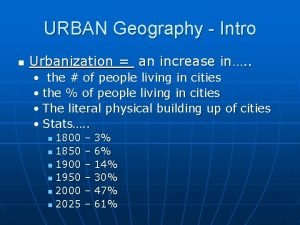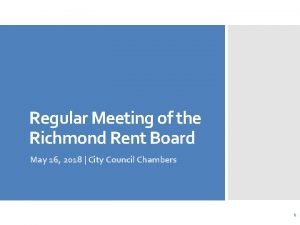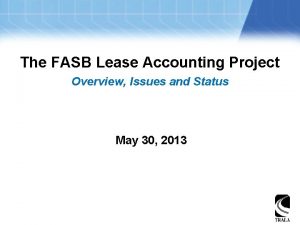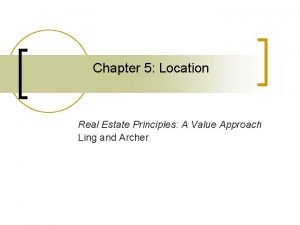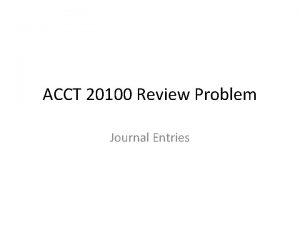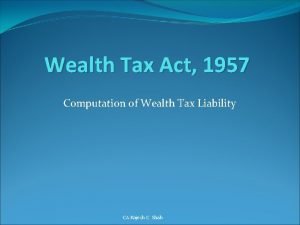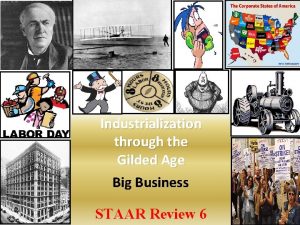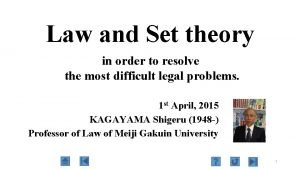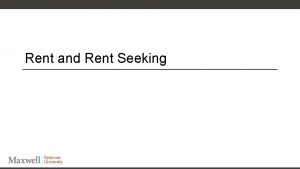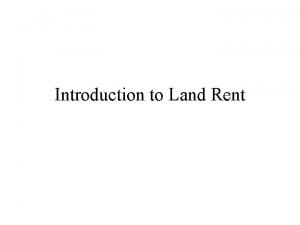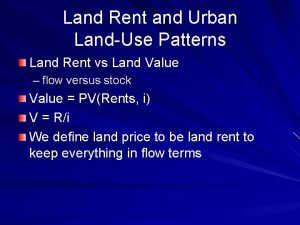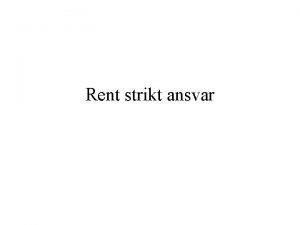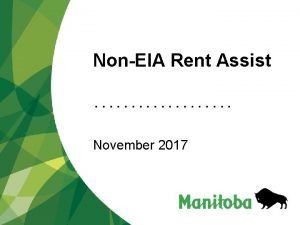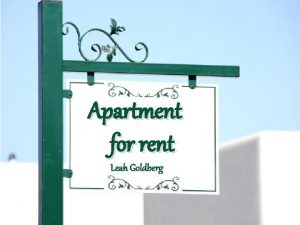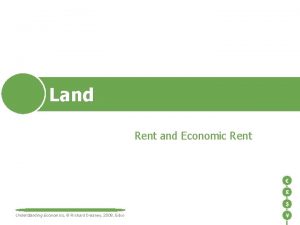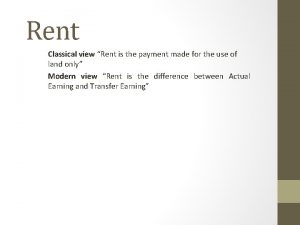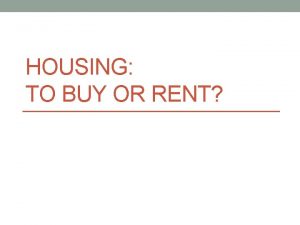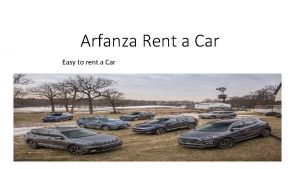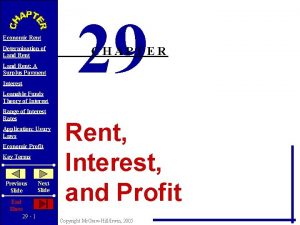Fun with Rent Functions We derived a rent



















- Slides: 19

Fun with Rent Functions!

We derived a rent gradient Remember, slope was related to mgl transport cost. Let’s assume that we have an open city. What does that mean? Rent Ag. Rent A> People can migrate from elsewhere. Utility can’t increase. Distance

We derived a rent gradient Suppose, everywhere that transportation costs decrease. Open city! What happens at u = 0. A> Nothing What happens elsewhere? Rent Ag. Rent Why? Distance

We derived a rent gradient Suppose, everywhere that transportation costs decrease. Closed city! What happens at u = 0. A> Rent falls Why? What happens elsewhere? Why? Rent Ag. Rent Distance

Let’s get more analytical (Brueckner Handbook) Two Eq’m conditions (18) (19) K = distance W = income t = mgl. Transp. Cost u = utility N = population

Land price rises (18) If RA , since W, t, and u are fixed, the only thing that can change is If land price rises, then people are worse off, so they move. City contracts until enough move out. Utility is constant. k = distance W = income t = mgl. Transp. Cost u = utility N = population

Income rises (18) What if W ? u can’t increase, so price of land (housing) must rise, as people move in to take advantage of increased W. At there is excess demand so the city must expand. Higher rents smaller housing higher density. k = distance W = income t = mgl. Transp. Cost u = utility N = population

Mgl. Transport cost rises (18) What if t ? u can’t decrease, so price of land (housing) must fall, as people move out. At there is insufficient demand so the city must contract. Lower rents bigger housing lower density. k = distance W = income t = mgl. Transp. Cost u = utility N = population

Closed city (18) Assume that N is constant. If RA , with N constant, If land price rises, less land for same number of people. Rents rise, housing prices rise. k = distance W = income t = mgl. Transp. Cost u = utility N = population

Closed city (2) What about a change in income W? Let p = price of housing k = distance W = income t = mgl. Transp. Cost u = utility N = population + + As W , people demand more housing, more land, and utility . Since you have the same number of people, if demand further out, some of it must decrease further in. KEY: What happens at k = 0? Increase in t does the reverse.

Open v. closed? • Costs of migrating may be high so utility differences may persist over time. • BUT, migration flows ultimately must eliminate differentials. • In real world, there is positive correlation between income and city population predicted by OC model. • Within a city you almost always want to do “open” analysis. Suppose you build a small park. Who will benefit? Why?

Land and. Labor Mkt. Eq’a

Revisiting Model Business Land Rent • We had business more centrally located. • Then residential. • At edge of the city, we get farmland. Residential Agric. City limits Distance

What is Zoning? • Zoning involves a set of restrictions on what people can do with their land. • Generally imposes the restriction with some sorts of public good in mind. • Discuss

Revisiting Model Business Land Rent • Suppose we forbid land development past a certain distance. What will the impacts be? • Immediate impact? • City ends at boundary! Service boundary Residential Agric. Distance City limits

More general effects. . . • Limiting size of city reduces labor supply – Wages rise, but, – This induces immigration from outside. • Since we have a smaller city, rents and density MUST RISE • Business sector bids less for land, because nonland costs have risen. . . • Residential sector bids land away from the business sector. So we will see. . .

Revisiting Model Business Land Rent • Ultimate impact depends on whether change is “small” or “large. ” • If it is “small” residents can’t be better off, because others would migrate in. Service boundary Residential Agric. Distance City limits

Ultimate winners and losers • In an open city, residents neither win nor lose. Migration keeps their utility constant. • Landlords outside the service boundary lose. • Residential landlords win. • Business landlords lose. • Zoning is about land.

Among urban areas, what must happen for business profits to be constant? Rent, R Equilibrium in the Land Labor Markets Increased R offsets decreased w U = u* Why? Among urban areas, what must happen for consumer utility to be constant? Increased R offsets increased w Re = * Why? Eq’m where 2 curves cross! Why? we Wage, w
 Absolute value as a piecewise function
Absolute value as a piecewise function How to solve evaluating functions
How to solve evaluating functions Evaluating functions and operations on functions
Evaluating functions and operations on functions Multicultural education in a pluralistic society
Multicultural education in a pluralistic society Accrued rent
Accrued rent Tenant rent calculation worksheet
Tenant rent calculation worksheet Pasture rent for cattle in kansas
Pasture rent for cattle in kansas Bid rent theory ap human geography
Bid rent theory ap human geography Multiple nuclei model definition geography
Multiple nuclei model definition geography City of richmond rent board
City of richmond rent board Fair housing delaware
Fair housing delaware Lease accounting project
Lease accounting project Rent real estate principles a value approach
Rent real estate principles a value approach Tds on conference hall rent
Tds on conference hall rent Tally erp 9 on rent
Tally erp 9 on rent Cash dividend received journal entry
Cash dividend received journal entry Computation of wealth tax
Computation of wealth tax Low wages high rent political cartoon meaning
Low wages high rent political cartoon meaning Theory definition
Theory definition Isirac rent a car
Isirac rent a car




